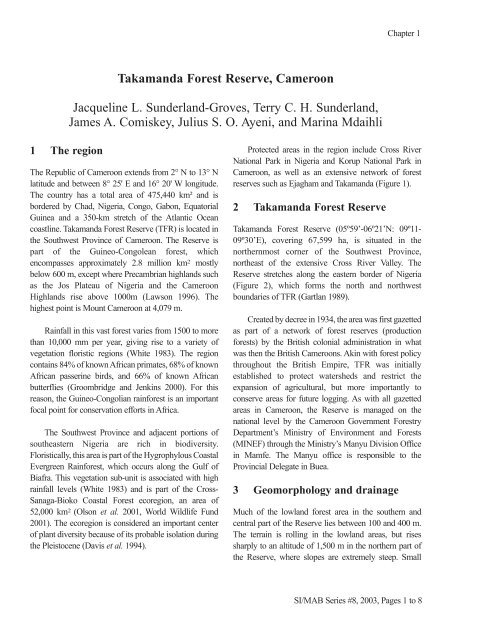Fisheries in the Southern Border Zone of Takamanda - Impact ...
Fisheries in the Southern Border Zone of Takamanda - Impact ...
Fisheries in the Southern Border Zone of Takamanda - Impact ...
You also want an ePaper? Increase the reach of your titles
YUMPU automatically turns print PDFs into web optimized ePapers that Google loves.
1 The region<br />
<strong>Takamanda</strong> Forest Reserve, Cameroon<br />
Jacquel<strong>in</strong>e L. Sunderland-Groves, Terry C. H. Sunderland,<br />
James A. Comiskey, Julius S. O. Ayeni, and Mar<strong>in</strong>a Mdaihli<br />
The Republic <strong>of</strong> Cameroon extends from 2° N to 13° N<br />
latitude and between 8° 25' E and 16° 20' W longitude.<br />
The country has a total area <strong>of</strong> 475,440 km² and is<br />
bordered by Chad, Nigeria, Congo, Gabon, Equatorial<br />
Gu<strong>in</strong>ea and a 350-km stretch <strong>of</strong> <strong>the</strong> Atlantic Ocean<br />
coastl<strong>in</strong>e. <strong>Takamanda</strong> Forest Reserve (TFR) is located <strong>in</strong><br />
<strong>the</strong> Southwest Prov<strong>in</strong>ce <strong>of</strong> Cameroon. The Reserve is<br />
part <strong>of</strong> <strong>the</strong> Gu<strong>in</strong>eo-Congolean forest, which<br />
encompasses approximately 2.8 million km 2 mostly<br />
below 600 m, except where Precambrian highlands such<br />
as <strong>the</strong> Jos Plateau <strong>of</strong> Nigeria and <strong>the</strong> Cameroon<br />
Highlands rise above 1000m (Lawson 1996). The<br />
highest po<strong>in</strong>t is Mount Cameroon at 4,079 m.<br />
Ra<strong>in</strong>fall <strong>in</strong> this vast forest varies from 1500 to more<br />
than 10,000 mm per year, giv<strong>in</strong>g rise to a variety <strong>of</strong><br />
vegetation floristic regions (White 1983). The region<br />
conta<strong>in</strong>s 84% <strong>of</strong> known African primates, 68% <strong>of</strong> known<br />
African passer<strong>in</strong>e birds, and 66% <strong>of</strong> known African<br />
butterflies (Groombridge and Jenk<strong>in</strong>s 2000). For this<br />
reason, <strong>the</strong> Gu<strong>in</strong>eo-Congolian ra<strong>in</strong>forest is an important<br />
focal po<strong>in</strong>t for conservation efforts <strong>in</strong> Africa.<br />
The Southwest Prov<strong>in</strong>ce and adjacent portions <strong>of</strong><br />
sou<strong>the</strong>astern Nigeria are rich <strong>in</strong> biodiversity.<br />
Floristically, this area is part <strong>of</strong> <strong>the</strong> Hygrophylous Coastal<br />
Evergreen Ra<strong>in</strong>forest, which occurs along <strong>the</strong> Gulf <strong>of</strong><br />
Biafra. This vegetation sub-unit is associated with high<br />
ra<strong>in</strong>fall levels (White 1983) and is part <strong>of</strong> <strong>the</strong> Cross-<br />
Sanaga-Bioko Coastal Forest ecoregion, an area <strong>of</strong><br />
52,000 km 2 (Olson et al. 2001, World Wildlife Fund<br />
2001). The ecoregion is considered an important center<br />
<strong>of</strong> plant diversity because <strong>of</strong> its probable isolation dur<strong>in</strong>g<br />
<strong>the</strong> Pleistocene (Davis et al. 1994).<br />
Chapter 1<br />
Protected areas <strong>in</strong> <strong>the</strong> region <strong>in</strong>clude Cross River<br />
National Park <strong>in</strong> Nigeria and Korup National Park <strong>in</strong><br />
Cameroon, as well as an extensive network <strong>of</strong> forest<br />
reserves such as Ejagham and <strong>Takamanda</strong> (Figure 1).<br />
2 <strong>Takamanda</strong> Forest Reserve<br />
<strong>Takamanda</strong> Forest Reserve (05º59’-06º21’N: 09º11-<br />
09º30’E), cover<strong>in</strong>g 67,599 ha, is situated <strong>in</strong> <strong>the</strong><br />
nor<strong>the</strong>rnmost corner <strong>of</strong> <strong>the</strong> Southwest Prov<strong>in</strong>ce,<br />
nor<strong>the</strong>ast <strong>of</strong> <strong>the</strong> extensive Cross River Valley. The<br />
Reserve stretches along <strong>the</strong> eastern border <strong>of</strong> Nigeria<br />
(Figure 2), which forms <strong>the</strong> north and northwest<br />
boundaries <strong>of</strong> TFR (Gartlan 1989).<br />
Created by decree <strong>in</strong> 1934, <strong>the</strong> area was first gazetted<br />
as part <strong>of</strong> a network <strong>of</strong> forest reserves (production<br />
forests) by <strong>the</strong> British colonial adm<strong>in</strong>istration <strong>in</strong> what<br />
was <strong>the</strong>n <strong>the</strong> British Cameroons. Ak<strong>in</strong> with forest policy<br />
throughout <strong>the</strong> British Empire, TFR was <strong>in</strong>itially<br />
established to protect watersheds and restrict <strong>the</strong><br />
expansion <strong>of</strong> agricultural, but more importantly to<br />
conserve areas for future logg<strong>in</strong>g. As with all gazetted<br />
areas <strong>in</strong> Cameroon, <strong>the</strong> Reserve is managed on <strong>the</strong><br />
national level by <strong>the</strong> Cameroon Government Forestry<br />
Department’s M<strong>in</strong>istry <strong>of</strong> Environment and Forests<br />
(MINEF) through <strong>the</strong> M<strong>in</strong>istry’s Manyu Division Office<br />
<strong>in</strong> Mamfe. The Manyu <strong>of</strong>fice is responsible to <strong>the</strong><br />
Prov<strong>in</strong>cial Delegate <strong>in</strong> Buea.<br />
3 Geomorphology and dra<strong>in</strong>age<br />
Much <strong>of</strong> <strong>the</strong> lowland forest area <strong>in</strong> <strong>the</strong> sou<strong>the</strong>rn and<br />
central part <strong>of</strong> <strong>the</strong> Reserve lies between 100 and 400 m.<br />
The terra<strong>in</strong> is roll<strong>in</strong>g <strong>in</strong> <strong>the</strong> lowland areas, but rises<br />
sharply to an altitude <strong>of</strong> 1,500 m <strong>in</strong> <strong>the</strong> nor<strong>the</strong>rn part <strong>of</strong><br />
<strong>the</strong> Reserve, where slopes are extremely steep. Small<br />
SI/MAB Series #8, 2003, Pages 1 to 8

















